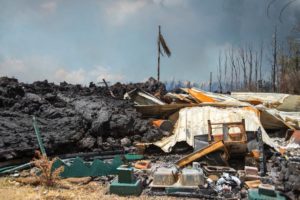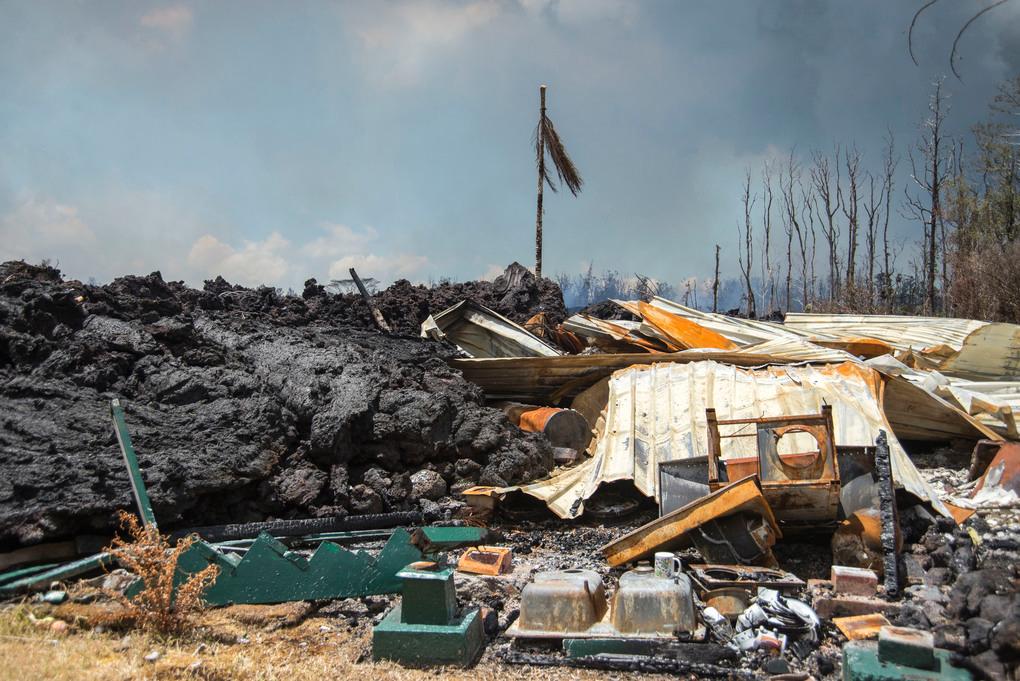In the Hawaiian religion, Tūtū Pele is the goddess of fire and volcanoes and the creator of the Hawaiian Islands. Hawaiians believe Kilauea to be inhabited by a “family of fire gods”, one of the sisters being Pele, who is believed to govern Kilauea and is responsible for controlling its lava flows. On May 1, 2018, Pele spoke, and Hawaii’s Big Island was rocked with the first of more than 50 earthquakes, representing the collapse of the crater floor at Puu Oo, the open vent below Kilauea’s summit crater and lava lake. Sulfur dioxide gas, debris and lava bubbled up through a new crack in the Kilauea volcano and, within a month, molten lava with a temperature of 2,200°F was flowing through and destroying entire neighborhoods before exploding in the ocean. Rivers of lava destroyed over 600 homes, making it the most destructive eruption in modern times. The resulting damage far surpassed the 215 homes destroyed by lava during a similar eruption of Kilauea in 1983. Even before the lava had cooled to form a tomb of solid rock over the once thriving neighborhoods, many escaped from their homes with their most valuable possession — their homeowner’s policy.

Hawaii is the home to five volcanos: Kohala, Mauna Kea, Hualalai, Mauna Loa and Kilauea. One is extinct, one is dormant, and the other three give homeowners just enough time to rebuild before they erupt again, repeating the cycle. These volcanos are extremely special and unique. Unlike most volcanos on earth, Hawaii’s volcanos are located nearly 2,000 miles from the place you’d normally find them — tectonic plate boundaries. Instead, they are formed because of the Pacific plate moving very slowly (4 inches per year) over a deep, stationary hotspot in the earth’s mantle. How and why homeowners would rebuild homes in the path of an active volcano and why insurance companies would continue to insure those homes against the inevitable remains a question that touches on the essence of the insurance industry and the human spirit.
The U.S. Geological Survey (U.S.G.S.) has created nine zones on the Big Island known as lava hazard zones. Zone 1 is the highest risk zone based upon the degree of the risk of hazard, historical flows, and the geography of the area. Zone 2 is also a high-risk zone based upon the same criteria. As the hazard zone number increases in number, the degree of risk decreases. Zone 9 is a zone of least risk. Properties in Zones 1 and 2 are some of the cheapest on the island. Property insurance is limited in these areas, but the Hawaii Property Insurance Association — a nonprofit created by the state legislature—offers some coverage up to $350,000, with any replacement coverage above that available only through Lloyd’s of London. Any possible volcano coverage comes with a steep price tag — an additional $3,000 or more per year for lava coverage. Even most lending institutions have curtailed or stopped altogether programs for financing in these areas, although the federal government offers a program through Rural Housing Development. You might as well be moving to Mars.
There is no such thing as volcano or lava flow insurance, but it is possible for an all-risk homeowner’s policy to provide some coverage. While most homeowners’ policies cover natural disasters such as floods and hailstorms, insurance for volcanos and lava flow has become incredibly rare and very expensive — especially in places like Hawaii. For those who live in designated U.S.G.S. lava-zoned areas, trying to get coverage is a monumental task. From the carrier’s perspective, it’s known as “anti-selection” — the tendency of individuals who suspect or know they are more likely than average to experience loss to apply for or renew insurance to a greater extent than people.
Many policyholders may have homeowners’ coverage but may not have paid the extra premiums to obtain protection from lava. There is usually coverage for vandalism and looting if the homeowners are displaced and there is anything left to loot. Damage to motor vehicles is covered under an automobile insurance policy if the owner has purchased comprehensive coverage. Ordinary property damage coverage applies if the car engine is damaged due to volcanic ash or dust.
Some homeowners argue they should be able to recover under the “fire peril” coverage of their policies. After all, the fire which ultimately destroys the home is a wildfire which, at some point in its development, was started by burning lava. Before lava even reaches the house, the house catches on fire because of the heat. Since the fire was caused by heat, there is an argument that it should be covered by insurance. On the other hand, many claims professionals say that insurance policies that exclude lava damage will not cover a fire caused by lava. If lava came down the hill, and the insured has a lava exclusion and trees catch fire, which burns the house, that’s not covered, according to some.
When it comes to commercial property insurance, the Broad Causes of Loss Form and Basic Causes of Loss Form — two of three ISO commercial property causes of loss forms — covers volcanic activity with the following language:
(11) Volcanic Action, meaning direct loss or damage resulting from the eruption of a volcano when the loss or damage is caused by:
(a) Airborne volcanic blast or airborne shock waves;
(b) Ash, dust or particulate matter; or
(c) Lava flow.
All volcanic eruptions that occur within any 168-hour period will constitute a single occurrence. This cause of loss does not include the cost to remove ash, dust or particulate matter that does not cause direct physical loss or damage to the described property.
The Basic Causes of Loss Form covers damage from the above-ground effects of a volcanic eruption — airborne blast and shock waves, ash, dust, particulate matter, and lava flow. It does not include, as detailed in the earth movement exclusion, the removal cost of volcanic ash or dust that has not physically damaged insured property, nor the seismic effects of a volcanic eruption. Coverage under this cause of loss applies to any volcanic eruptions occurring within a seven-day period (168 hours). Under the original versions of the form (prior to the 1988 revisions), this period was three days.
On the other hand, the Special Form Policy covers all risks unless excluded. While it covers volcanic eruption, it then excludes “volcanic eruption”, leading to the following coverage:
(5) Volcanic eruption, explosion or effusion. But if volcanic eruption, explosion or effusion results in fire or Volcanic Action, we will pay for the loss or damage caused by that fire or Volcanic Action.
As a result, many ash claims will be denied because the ash arguably does not result in any “physical damage.” Until recently, volcanic action coverage was only available through an optional endorsement. Businesses must usually wait 72 hours before business interruption coverage kicks in. However, the insurance industry has begun to clamp down on business interruption claims resulting from volcanic activity because the losses (e.g., shutdown of busy airports, etc.) are simply too great.
Homeowners affected by mandatory evacuations, fire, smoke, or noxious fumes may be able to make a claim. Obviously, insured homeowners must look carefully at their policies and parse the details of its terms, conditions, and exclusions. On the other hand, the problem is getting insured. State Farm stopped writing homeowners’ policies in Zones 1 and 2 in the 1990s, but it grandfathered in people with existing policies. Those policies usually cover fire from volcanic activity, but each claim must be looked at individually. According to State Farm’s website, “Most homeowners’ policies provide coverage for property loss caused by volcanic eruption when it is the result of a volcanic blast, airborne shock waves, ash, dust, or lava flow. Fire or explosion resulting from volcanic eruption also is covered.” They do not cover “damage from earthquake, land tremors, landslide, mudflow, or other earth movement regardless of whether or not the quake is caused by or causes a volcanic eruption.” The problem is getting insurance.
Volcano coverage can confuse even experts on the subject. Gordon Ito, Hawaii’s insurance commissioner since 2010, originally said that homes destroyed by Kilauea were covered for the damage under homeowners’ policies, but later clarified that coverages and exclusions varied from policy to policy and many homes may not have been covered. Coverage shouldn’t vary from zone to zone, but premiums will. If property is in a higher-risk area, it will cost more.
Insurance notwithstanding, a much greater question involving the human spirit comes into play when discussing building homes and communities in places in the path of an active volcano or below sea level and protected by a thin concrete levee. Following Hurricane Katrina in 2005, many argued that the city should not be rebuilt because it is built on the sinking Mississippi River delta complex. As man-made levees have kept sediments from being deposited in inhabited areas, much of the city is now below sea level and at an even greater risk. Katrina will be repeated. In 100 years, New Orleans will be three to five feet lower than it is today. To maintain the river’s course through New Orleans, levees had to be built from the mouth of the Mississippi to New Orleans and up the river. Years ago, the Mississippi River normally would have taken a more direct route to the sea than through New Orleans. The city’s very existence is a losing tug of war against nature itself. This is why 15 New Orleans zip codes saw the largest drop in home prices in the U.S. in 2017.
Similar criticisms are leveled at the rebuilding of neighborhoods and communities directly in the path of future eruptions of Kilauea. In Hawaii’s Volcano Country, the land is cheap, and life is risky. The reward of low home prices is offset by the very real risk of complete destruction. It isn’t a question of if, but when the next catastrophe will strike. To expect the insurance industry to simply provide a safety net for what might aptly be called a “pre-existing condition” is counterintuitive to the concept of insurance itself. To “insure” means to “arrange for compensation in the event of future damage or loss and secure against a possible contingency in the future.” When the contingency is a certainty, it stops being insurance and veers wildly outside of the economic system we know as “free enterprise.” Compassionate and caring answers do not come easily when dealing with the certainty of future natural disasters. While the human heart strives for compassionate answers, another organ from which originates common sense compels an outcome where the risk is commensurate with the reward.
Putting aside the risk and reward mumbo-jumbo which is the stuff of underwriting, when a volcano causes a loss, the concept of subrogation isn’t something that usually comes to mind. Whether you blame God or Pele, when a volcano strikes, the resulting losses can be enough to put many insurance companies into receivership. With no third parties or obvious subrogation potential, these mammoth claim payments often disappear permanently. Acts of God such as these reveal a celestial tortfeasor who is both judgment proof and beyond reach by summons and subpoenas. However, rather than throwing in the towel, these losses present tremendous recovery potential for the proactive claims professional. It is said that opportunity is missed by most because it is dressed in overalls and looks like work. Nowhere is that adage truer than when it comes to subrogating natural disasters. If a carrier is willing to invest the time and effort necessary to investigate third-party potential in the face of disaster, it is possible to turn tragedy into triumph.
While liability for causing the volcano is beyond the reach of the civil justice system, subrogation potential may exist where the resulting fire intensified and spread due to the defendant’s negligence. For instance, in Dealers Serv. & Supply Co. v. St. Louis Nat. Stockyards Co., 508 N.E.2d 1241 (Ill. App. 1987), a property owner who suffered loss due to a wildfire sued an adjacent property owner alleging that adjacent property owner negligently and carelessly maintained its property so as to create conditions hazardous to the property owner’s land and allowed the fire to spread much faster. The defendant failed to prevent the dumping of combustible materials and the growth of weeds on its property despite being aware of open fires on its property. Nobody supervised the vacant land, there was no system of maintenance for the property, and the weeds had never been cut. Even though the cause of the fire was never established, firemen testified that the fire started in the weeds and spread to the plaintiff’s building, aided by a wind from the west. While the typical case for recovery relating to a wildfire would pertain to the fire’s ignition, a fire’s spread may also present an opportunity for the subrogating insurer.
Subrogating volcano losses is not for the faint of heart. Prompt investigation is required, and experts will be needed to assess ignition, spread, prevention, and damage if a carrier wants to see a recovery. One thing is certain: a carrier will fail at recovering every claim in which it takes no steps toward investigating subrogation potential.
Was this article valuable?
Here are more articles you may enjoy.



 AI Weather Models Promise Super Granular, Specialist Forecasts
AI Weather Models Promise Super Granular, Specialist Forecasts  Tariffs Threaten to Push US Home Insurance Rates Even Higher
Tariffs Threaten to Push US Home Insurance Rates Even Higher  Insurance Industry Contemplates Knock-On Effect of Tariffs to Claims, Consumers
Insurance Industry Contemplates Knock-On Effect of Tariffs to Claims, Consumers  EU Adopts Tariffs on $23B Billion of US Goods in Metals Fight
EU Adopts Tariffs on $23B Billion of US Goods in Metals Fight 